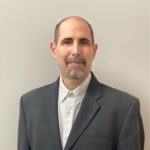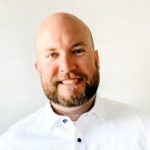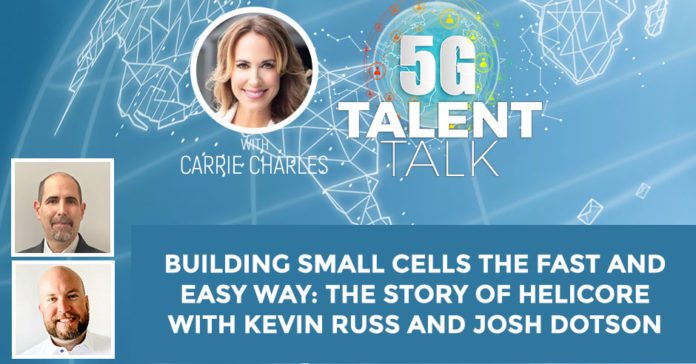While 5G services are in demand, the deployment of this technology can often cause disruption. The Helicore team has found a fast and easy solution to the disruptions caused by 5G densification and deployment – building small cells. In this episode, Carrie Charles interviews Co-founders Kevin Russ and Josh Dotson on the progress done by their company and the patented technology they use. Kevin and Russ talk about getting their start in the telecoms industry and their future goals. An interesting discussion that people looking into deploying 5G services should not miss out on.
—
Watch the episode here
Listen to the podcast here
Building Small Cells the Fast and Easy Way: The Story of Helicore with Kevin Russ and Josh Dotson
We have an exciting episode. Two of my friends in the industry are the Founders of a company called Helicore. Kevin Russ, who is the Chairman and CEO and Josh Dotson, who is the Vice President of Corporate Development for Helicore. Gentlemen, thank you so much for joining me on the show.
It’s a pleasure, Carrie.
We’ve known each other for a while. I remember when you started Helicore. There’s such an exciting story and journey. Can you tell me a little bit about how Helicore was born, the vision and the story behind the company?
It begins a little bit with my history. I’ve been in telecom for many years but before that, I used to design and build ski lifts and aerial tramways. I’m an old foundation guy, putting foundations in places that would blow people’s minds. Believe it or not, the birth of Helicore, in a way, was back in the ski industry in the mid-‘90s when I learned about the technology that we’re using.
As you would you go through life, you have different experiences, careers and you think, “When am I ever going to use this again? How is this all going to connect?” Did it connect for you?
Yes, 25 some odd years later.
Josh, what’s your background and how did you come to get involved with Helicore?
Kevin and I met years ago. I was in the locating industry. If anyone is in the AME or Sci-Tech world reading this, they know that 811 is typically not enough for what we’re doing. That’s how I met Kevin. Just through industry events and speaking on panels together, we got closer and kept talking about this. From some of the projects we did together, he realized the accuracy of what’s out there, the knowledge of some people have and that’s where we put this whole thing together.
Tell me about the company, the service and what problem does it solve?
Helicore is a patented foundation solution that allows streetlight replacements for 5G or 4G poles, even your normal street lights to be completed in one day in the same exact location as the original while also giving you flexibility in the field to work around whatever challenges may arise during construction. It’s one size fits all.
We don’t solve every problem but we solve a lot of problems.
Kevin, do you have any thoughts on why was this important and such a need in our industry?
It solves a major problem for municipalities because, with the way things are currently done with concrete, the municipalities only have two choices. They can put a new foundation next to it so that they can keep the streetlight on and they don’t have lights out, which is a safety issue but then that alters their streetscape. The poles are not evenly spaced and/or the other choice that the municipalities have is to keep it in the same location but then have lights out for an extended period of time because concrete takes time to cure. It’s a multi-day process versus a one-day process that we can do. It keeps it in the same location and has the light back up that night.
I want to talk a little bit more about small cells and back up a bit for those people that are reading that may not have the experience with small cells. Give an explanation of what small cells are, their role in the deployment of 5G and also how many small cells are going to be deployed in the next 5 to 7 years?
The best way is that small cells are used for 4G for densification and 5G to go on wooden utility poles. In areas where there aren’t wooden utility poles, they have to use the streetlights to put them on because for the real 5G that you keep hearing about in the commercials and advertisements, these are it on every street corner. The end-user and the bandwidth that’s involved with it requires them to be not on the typical multiple that you see cell site. They’re going to be down on the street, right where the people are. Our product solves the problem in areas where the street lights have to be replaced. In areas where there are utility poles, it makes more sense to use those. We don’t solve every problem but we solve a lot of problems.
It is like a typical business. You’re very focused on what you do and you do it very well. What’s the need out there, Josh? How many small sales are going to need to be deployed in the next five years or so? What do you think?
We did a lot of research to see what the real market size is. We used a lot of channels and talked to a lot of people. From what we’ve come up with, it’s far into the million That’s a mixture of streetlights than with utility poles and even rooftops. When you think about every urban environment in the country, you’ve got ballparks, shopping malls, schools, downtown events, the streetlights are there. You can see in every city you walk through, the assets are there. We need to use them as far as the million.
What are the challenges with deploying small cells? For service providers, municipalities, what are they facing?
There are a lot of challenges. They’re different for every person. Every different task has different challenges tied to it. The main one I see, based on my background, is fitting something rigid, like a concrete case on into a very densely congested right way. Every downtown area, if you’re right way is underground, you have water, sewer, gas, electric, fiber, even old steam lines, you name it. Having that flexibility in the field to work around those things on the fly allows that your bill will get done when the sidewalk is opened up, not three months later.
That’s for the service provider side. As far as municipalities, with the typical concrete foundation, you have to come in and dig a hole. You have to form it up, you have concrete trucks coming in and then you have to wait for the concrete to here. It becomes a multi-day process. If hundreds are going in an area, that can upset residents. The municipalities want the service but they want it to look good and done quickly with minimal disruption. That’s what Helicore does.
How fast can Helicore get a small cell up and deploy each one?

The fastest one we’ve done so far is 3.5 hours.
We say 1 to 2 days because normally you’re reporting the concrete the next day but the actual pole in most cases is standing in hours, not days. From taking the streetlight down, putting it in our system, then putting the new pole up and the light being back functional that evening. It’s very fast. We talk about days but the reality is hours. We partner with a lot of GCs around the country. It’s interesting to see once crews use our system, they don’t want to ever do concrete.
The GC’s time is money. Faster is always better.
If your pole is standing the same day, you built your foundation. Your RF crew is mobilizing the next day. There’s no delay. We get that speed to market down by the efficiencies we can gain.
The other thing that I’ve heard back from a lot of construction managers is it makes their life easier because when they’re pouring concrete, then once the foundation’s in there, they have to line up getting the pole stood up. By using us, there’s less coordination. It makes everything go faster, easier and gets it done. These are ballpark numbers but to date, I want to say that there are roughly 130,000 small cells that have been done. If you think about going into the millions, things have to speed up and concrete only hears fast.
It’s cool that you talk about where you were from the idea. I have an idea of everything that you’ve gone through. Who are your customers? What makes you different in the way that you do business?
Our end customers are the carriers and CLX, anybody that’s building a small cell or even municipalities that maintain their street lights. The way we work is we work with our GC partners that work with the end customers. We’re easy to work with. We make it an easy button.
The obvious one is the small cell play. All the carriers and people that are building small cells but Kevin mentioned municipality. We’re working with a few that maintained their street lights. This blew my mind. Cars hit streetlights all the time and we call them knockdowns. When that happens, the city has to come back out. If you have a concrete foundation, your anchor bolts are tied into your concrete, the concrete breaks, you have to redo the whole foundation. How many times are you going to do that? We’ll work with the municipality, supply them the materials, train their crew and they can go out and build this. The second time that pole gets hit, all they’re doing is replacing bolts. They unscrew them, screw them back in and stand back their pole. It’s a new niche for us. We didn’t think that could be there.
I have a confession to make. I’m one of those people that hit a pole and maybe you repaired it, possibly. I get it.
It’s funny you say that because my dad reminded me when we started Helicore or we were doing all this that when I was in high school, I had a light pole in our high school parking lot and he laughed. He goes, “You are destined to be in light poles.”
Every different task has different challenges tied to it.
Let’s talk about back to the excitement around taking the idea from concept to reality. I love to share this with the audience because I’m sure people reading, thinking, “I have an idea. How did they do this? How has it been done?” Many people have an idea. Many times you don’t act on your idea as an entrepreneur and then you see it, somebody else acts on it and then it gets sold for $100 million and you’re kicking yourself. What advice would you give to people that have an innovative idea and they want to bring it to market?
I would start off with persistence, patience and having great partners is key. There were times when we were getting this going where it was difficult and it’s almost like you feel like you want to throw in the towel but having a partner like Josh keeping me up, when he’s down, I keep him up and we keep moving forward. If you have something that solves a problem, then you need to stick with it, get it out there and have a great network, work your network, talk to people and be persistent.
Be a problem solver. You have to fix the pain points that you know that are out there, use it, have your network use it and make it a benefit.
What’s interesting about your partnership too and correct me if I’m wrong but it seems to me like the two of you were yin and yang. You each have different strengths. When you’re looking for a partner and somebody to partner with, I know this is within the broad staff as well, that leaders are very different and we each bring something different to the table versus looking for someone who’s exactly like you and, “This person’s just like me,” so they’re going to be a perfect partner. Maybe not. You need someone that is different and has a different genius skill than you do.
Kevin is the Math guy. He’s the one that can do all the engineering in his head. I’m the one that talks to people. He’s way smarter than I am.
In different ways, Josh. Let’s talk a little bit more about the challenges that you’ve had to overcome. You started this business in March of 2020, which was not the greatest time to start a business. Talk about the challenges that you’ve been through.
We started on March 1, 2020. I flew to Chicago to meet Josh, picked me up and we had a meeting. I flew back and that was the last flight, two days before everything locked down. At first, we are scared like, “What is this going to do to our business?” Working together and looking for the positive, it’s a positive for us because we’re able to get the number of meetings via Zoom and everything else, where we would have been flying around the country to meet with people. That’s just the way the business was done before that. Josh can further explain but where we had one customer where we had a Zoom meeting with our Northern Texas team and literally backed it up to a Zoom meeting with our Southern Texas team where pre-COVID, that would have been two flights and days. It’s given us the opportunity that if we were to have to fly for every meeting, we’d probably be 2 or 3 years down the road of where we are.
On the sales side or people side, which is where you sit and your genius lies and I know I’ve talked to many people on business development in 2020 and they’ve said, “How difficult and challenging it is,” because they can’t see people. I love Kevin’s perspective because it’s so positive. Your seat having to grow this company from zero to where you are. What have been the challenges on that business development side for you?
It’s always tough because there’s no replacement for face-to-face. You need to network with people, read body language and set that personal relationship. It’s difficult to do over Zoom, Teams or whatever you’re using. By looking to the positive, you have to make it work. What’s the alternative? Have you thrown a towel because you can’t go see someone? No, we’re going to make it work. We made it personal. We lined up meetings as the customers want us to. We are years ahead of where we would have been because I’m used to the flights, hotels and all that but we made it work.
Let’s talk about the future. You’ve come so far. It’s unbelievable how far you’ve come but I know that you have big goals and big dreams for the future. What is happening and where will Helicore be in five years?

My goal is that we’re the standard way to replace street lights throughout the industry and we’re getting there. I would like everyone to be done our way. Do I think that will happen? I think we’ll get close but we’ll never go to replace concrete. Concrete is there. It just depends on the area and if they know that there are no utilities, I’d like to become the standard.
Double back to the municipalities. These cities that are the main thing are on the streetlights. All these crews are on the staff of the city. They’re being paid regardless. Let’s all work together to make this happen. Kevin hit on this earlier, if millions are needed and there’s only been, let’s say, under 150,000 small cells built, how are we going to get there? Is this going to take twenty years? Everyone’s goal is 25% of that. Something’s got to change.
What about going outside the US? Do you have plans for that?
We have filed our patent cooperation 3D and our PCT filing. We’re planning in 158 countries. We’re choosing which countries. We have our partner in the EU, UK, Canada and Mexico, then we’re looking at where else we’re going to go from there.
Let’s finish up with, what would you say as an entrepreneur? You’ve been doing this since March 2020. What you say is the number one thing that drives you to success and it gets you up every morning, ready to go, to make a difference and perform for your customers?
This goes back to the beginning. We started every day looking for, “Let’s just get one win.” It then turned into, we’re getting more than one win a day. That’s what keeps us going and the more that we get out there, we can give our presentation, show people pictures and everybody gets it but there’s still a question mark of, “How can you do it this fast?” Once they see it done, it continually building on itself. I feel like that’s the excitement of it because we were excited about the product, how it works and to see these construction crews equally excited keeps the drive going.
It’s that a-ha moment when someone gets it right that usually comes from a GC in the field once they install it and say, “That’s it.” I trained a crew in Louisiana, top-notch guys with three people. We built three foundations in 1.5-day. That was with me training them. They were blown away. They don’t want to go back to the old way because they just did three in 1.5-day. That would never happen. It’s that a-ha moment that you solve someone’s problem or you made the pain go away. That’s everything.
I’d love to hear the passion in your voice. It’s exciting. I cannot wait to see what the two of you do with Helicore. How can the audience reach you? I’m sure there are people in the audience that are thinking, “I want to hire these guys because I need help and they need to do this for me.” Where could you be reached?
Our website, www.Helicore.co. You could also hit us up on LinkedIn. Kevin and I are both on there, so either or.
This has been a beautiful interview. I love the story, from idea to making it happen, developing it and watching your success. I’m sure it’s an inspiration to all that are reading. Thank you so much for being on the show. I wish you all the success in the world. I’m going to see you at ConnectX. We get together again.
The municipalities want the service but they want it to look good and done quickly with minimal disruption. That’s what Helicore does.
Thank you so much.
We appreciate it, Carrie.
You are so welcome. You take care. We’ll see you soon.
Important Links
About Kevin Russ
 Kevin is a seasoned executive with over 30 years of experience in program/project management in the wireless communication and aerial tramway industries, both domestic and internationally. Kevin is a hands-on, lead-from-the front executive who is extremely passionate about developing America’s telecommunications infrastructure. Kevin has extensive experience leading and building internal and external relationships, project teams (large & small), and partnerships on complex regional and nationwide projects from $5MM to $100MM.
Kevin is a seasoned executive with over 30 years of experience in program/project management in the wireless communication and aerial tramway industries, both domestic and internationally. Kevin is a hands-on, lead-from-the front executive who is extremely passionate about developing America’s telecommunications infrastructure. Kevin has extensive experience leading and building internal and external relationships, project teams (large & small), and partnerships on complex regional and nationwide projects from $5MM to $100MM.
About Josh Dotson
 Josh leads Helicore customers in overcoming the challenges they face today in 5G network densification. With a global perspective, the entrepreneurial-minded Dotson is a recognized expert in business processes related to telecom construction and infrastructure, with several national speaking credits to his name. His career has focused on practical applications and optimization with a highlight on developing technology that disrupts the status quo.
Josh leads Helicore customers in overcoming the challenges they face today in 5G network densification. With a global perspective, the entrepreneurial-minded Dotson is a recognized expert in business processes related to telecom construction and infrastructure, with several national speaking credits to his name. His career has focused on practical applications and optimization with a highlight on developing technology that disrupts the status quo.
As a National Business Development Lead at the nation’s largest private utility locating firm, Dotson created a sales focus for specific market verticals such as telecommunications, power transmission, power generation, and the environmental field. He launched his career with GPRS in project management, eventually handling sales on a national level with consistent +100% year over year growth.

